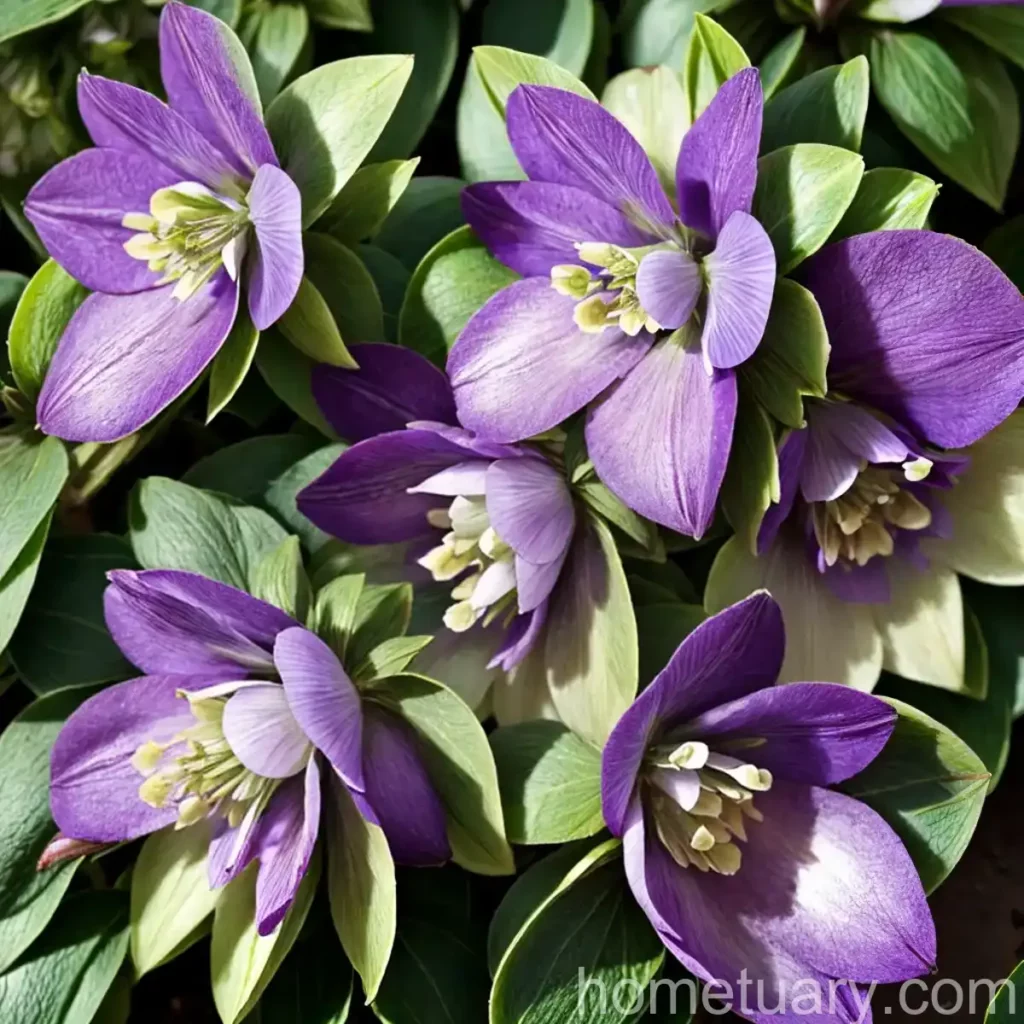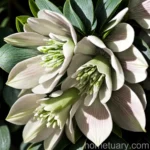Hellebore (Helleborus orientalis subsp. abchasicus (Early Purple Group)
Hellebores, also known as Lenten roses, are perennial flowering plants that belong to the genus Helleborus and the family Ranunculaceae. The Helleborus orientalis subsp. abchasicus, specifically the Early Purple Group, is an enchanting variety within this diverse plant family. This blog post aims to provide an in-depth understanding of the hellebore (Helleborus orientalis subsp. abchasicus (Early Purple Group)), focusing on its culture, uses, care requirements, common diseases, pests, fun facts, and more.
What is Hellebore (Helleborus orientalis subsp. abchasicus (Early Purple Group))?
Helleborus orientalis subsp. abchasicus (Early Purple Group) is a flowering perennial plant native to the Caucasus region. It is known for its stunning, nodding, bell-shaped flowers that bloom in late winter or early spring, often amidst the snow. This particular variety is cherished for its early blooming nature, adding a delightful pop of color to the winter garden landscape. The plant’s lush, green foliage serves as an excellent backdrop for the unique flowers, which come in various shades of purple, providing a charming visual appeal.
Hellebores are revered for their ability to thrive in challenging conditions and are often found in shade gardens, woodland settings, or as ornamental additions to landscapes. With proper care and attention, they can grace a garden with their elegant blooms for many years, making them a favorite among gardeners and horticulture enthusiasts.
Key Takeaways – Hellebore (Helleborus orientalis subsp. abchasicus (Early Purple Group))
Before we delve into the specifics of cultivating and caring for Helleborus orientalis subsp. abchasicus (Early Purple Group), here are some key takeaways about this delightful plant:
- Scientific Name: Helleborus orientalis subsp. abchasicus (Early Purple Group)
- Common Name: Hellebore
- Blooming Period: Late winter to early spring
- Flower Colors: Various shades of purple
- Particular Feature: Nodding, bell-shaped flowers
- Preferred Growing Conditions: Shade, well-drained soil
- Cultural Importance: Ornamental plant, used in shade gardens and woodland landscapes
Now, let’s explore the essential aspects of cultivating and caring for hellebores to ensure their optimal growth and blooming.
Culture
Uses
The Helleborus orientalis subsp. abchasicus (Early Purple Group) serves several purposes, making it a versatile addition to a garden or landscape. Some common uses of hellebores include:
- Ornamental Plant: The elegant and unique appearance of hellebore flowers makes them popular as an ornamental addition to gardens and landscapes.
- Shade Gardens: Hellebores thrive in shaded areas, making them a valuable choice for landscaping and gardening in such environments.
- Winter Blooms: Their early flowering period brings color and vibrancy to gardens when most plants are dormant, adding visual interest during the winter months.
Water
Moderate watering is essential for the healthy growth and development of Helleborus orientalis subsp. abchasicus. While the plant prefers moist soil, it is crucial to ensure proper drainage to prevent waterlogging, which can lead to root rot and other issues. During periods of prolonged drought, providing additional water can help maintain the plant’s vitality and support optimal blooming.
Sunlight
One of the defining features of Helleborus orientalis subsp. abchasicus is its preference for shade or partial shade. While it can tolerate some direct sunlight, especially in the cooler parts of the day, prolonged exposure to intense sunlight can cause the plant’s foliage to scorch. Thus, locating hellebores in shaded areas, such as under deciduous trees or along north-facing walls, is recommended for their optimal growth and blooming.
Fertilizer
Applying a balanced, slow-release fertilizer in early spring can provide the necessary nutrients for hellebores to thrive. Additionally, incorporating organic matter into the soil during planting or as a top dressing can support the plant’s overall health. It is essential to avoid over-fertilization, which can lead to an imbalance in nutrients and potentially harm the plant.
Soil
Helleborus orientalis subsp. abchasicus thrives in well-drained, humus-rich soil. A slightly acidic to neutral pH level is ideal for optimal growth. Adding organic matter, such as compost or well-rotted manure, can improve soil structure and fertility, creating a conducive environment for hellebores to flourish.
Pruning
Pruning hellebores is generally minimal, focusing on the removal of old, damaged, or unsightly foliage and spent flowers. Regular deadheading can promote continuous blooming and maintain the plant’s aesthetics. It is essential to exercise caution when handling the plant, as all parts of hellebores are toxic if ingested and can cause skin irritation in some individuals. Wearing gloves while pruning is advisable.
Propagation
Helleborus orientalis subsp. abchasicus can be propagated through various methods, including division, seed sowing, or tissue culture. Dividing established clumps in early spring or late summer can help rejuvenate the plant and create new specimens. Collecting and sowing seeds can also yield new hellebore plants, with careful attention to the required conditions for germination and growth.
Container Popularity
The compact nature and stunning blooms of Helleborus orientalis subsp. abchasicus make it an excellent choice for container gardening. Whether as a focal point on a patio or terrace or as part of a shaded container garden, hellebores add elegance and visual appeal to outdoor spaces. When cultivating hellebores in containers, selecting a well-draining potting mix, providing adequate water, and ensuring appropriate sunlight conditions are crucial for their successful growth.
Common Diseases
Understanding and identifying common diseases that can affect Helleborus orientalis subsp. abchasicus is crucial for maintaining the plant’s health and vitality. Some of the common diseases that hellebores may encounter include:
- Crown Rot: This fungal disease can lead to the decay of the plant’s crown and roots, often caused by waterlogged soil or poor drainage. Symptoms include wilting, yellowing foliage, and overall decline in plant health.
- Leaf Spot: Leaf spot diseases, caused by various fungal pathogens, can manifest as dark spots or lesions on the plant’s foliage, leading to reduced photosynthetic capacity and aesthetic deterioration.
- Powdery Mildew: Powdery mildew can affect hellebores, resulting in a powdery, white growth on the upper surface of leaves. This can hinder the plant’s ability to photosynthesize and weaken its overall vigor.
Diagnosing these diseases accurately and promptly is vital for implementing appropriate management practices to mitigate their impact and prevent further spread.
Disease Diagnosis
When diagnosing diseases in Helleborus orientalis subsp. abchasicus, careful observation of the plant’s symptoms is essential. Identifying characteristic signs such as leaf discoloration, wilting, or unusual growth patterns can help narrow down the potential causes of the issue. Additionally, seeking the expertise of a plant pathologist or horticulturist can aid in accurate disease diagnosis and the development of effective management strategies.
Common Pests
While hellebores are relatively resistant to many pests, they may still encounter certain insect adversaries that can impact their growth and blooming. Some common pests that may affect Helleborus orientalis subsp. abchasicus include:
- Aphids: These small, sap-sucking insects can cluster on the undersides of leaves, causing yellowing, distorted growth, and reducing the plant’s overall vigor.
- Slugs and Snails: These mollusks can feed on hellebore foliage and flowers, leaving behind characteristic feeding damage and holes, particularly in damp conditions.
- Spider Mites: Infestations of spider mites can lead to stippled or discolored foliage, often accompanied by fine webbing on the plant, affecting its overall health and appearance.
Implementing integrated pest management practices, such as regular monitoring, maintaining a healthy garden ecosystem, and targeted interventions when necessary, can help protect Helleborus orientalis subsp. abchasicus from pest infestations.
Botanist’s Tips
Botanist’s Tips for Successfully Growing Helleborus orientalis subsp. abchasicus:
- Shade Preference: Provide adequate shade or partial shade to ensure optimal growth and blooming.
- Well-Drained Soil: Ensure the soil is well-drained and rich in organic matter to support the plant’s root health and vitality.
- Prudent Pruning: Exercise caution and wear appropriate protection when pruning hellebores to avoid skin irritation and toxicity concerns.
- Integrated Pest Management: Monitor and manage pest populations using environmentally friendly methods to protect the plant without harming beneficial organisms.
Following these tips can contribute to the successful cultivation and thriving of Helleborus orientalis subsp. abchasicus in various garden settings.
Fun Facts
Uncover some intriguing and delightful fun facts about Helleborus orientalis subsp. abchasicus:
- Historical Significance: Hellebores have a rich history and have been cultivated for centuries, with various cultural and medicinal uses attributed to them.
- Winter Cheer: The early blooming nature of hellebores brings joy and color to gardens when little else is in bloom, earning them the endearing nickname “Lenten roses.”
- Deer Resistance: Hellebores are often considered deer-resistant plants, making them a valuable addition to gardens frequented by these wildlife species.
- Antiquated Beliefs: In folklore and traditional practices, hellebores were believed to possess mystical and protective properties, adding to their allure and significance in various cultures.
Exploring these fascinating aspects of Helleborus orientalis subsp. abchasicus can deepen your appreciation for this enchanting plant and its captivating charm.
Links to External Resources
Enhance your knowledge and understanding of Helleborus orientalis subsp. abchasicus with the following external resources:
- Royal Horticultural Society – Hellebores
- American Society for the Prevention of Cruelty to Animals – Hellebore Poisoning in Dogs
- University of Maryland Extension – Controlling Pests Safely
By exploring these resources, you can broaden your understanding of hellebores and gain valuable insights into their cultivation, care, and potential uses.
In conclusion, Helleborus orientalis subsp. abchasicus (Early Purple Group) encompasses a blend of beauty, resilience, and historical significance, making it a prized addition to gardens and landscapes. By embracing its unique characteristics and understanding its specific cultural needs, you can embark on a rewarding journey of cultivating and appreciating the exquisite charm of this captivating plant.
As you venture into the world of hellebores, remember to cherish their early winter blooms, savor their rich folklore, and nurture them in line with their preferred growing conditions. These efforts will not only sustain the vitality of Helleborus orientalis subsp. abchasicus but also enrich your connection to the natural world and its wondrous offerings.
Happy gardening and may the enchanting allure of hellebores grace your outdoor spaces with timeless elegance and natural splendor.















